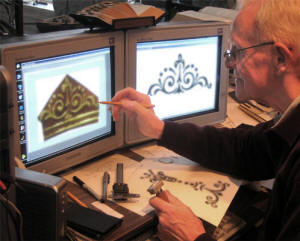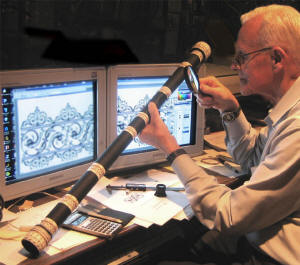Replicating the art work
of IMSS #2428
We do not believe that Galileo intended
this beautiful and extraordinary telescope to go to
just a colleague but rather to a customer of high rank
and station. This is an important part of the Galileo
story. It is a symbol of Galileo's marketing and entrepreneurship. While
there is no strong evidence that Galileo would have done
the gold leather stamping himself his choice of
the artisan was as critical to him as the rest of
the detail of producing this telescope. Beauty and flattery
had to be part of his skill set.
Because of the very important symbolic nature of
these telescopes it is more than worth while to
reproduce them accurately. It is only fair to anyone who
has taken the time to stop to learn, to
admire and respect Galileo's work (in one of its finest
moments of basic scientific
research) to have the best to visit and learn
from.
Developing the art work from photos
contains many complex issues. (such as correcting for barrel distortion in the camera etc.). It has been a slow and
exacting process extracting the shape and detail of each
of the deco elements from our high resolution photos
which show each dent, scratch, warp and hand made
irregularity. Rhoda and I have spent hundreds of
pleasant hours deciphering and unfolded the detail to
get as close a match to the orginal hot stamp as
possible. the outcome of our work are more than 20 hot
dies at about $200 a die, (We had to make 2 & 1/2 sets to get them right) a considerable
expense that both Galileo and we have shared in making these telescopes. Note the
comment that we have high lighted in red in Galileo's 1610 letter to the
Tuscan court
below.
Below is the
translation of Galileo's letter
19th of March 1610 to the Tuscan
court
.From
A English translation of Galileo's
letter ref.1
|
"In
order to maintain and
increase the renown of these
discoveries, it appears to
me necessary to have the
truth seen and recognized,
by means of the effect
itself, by as many people as
possible. |
I
have done, and am doing, this in Venice
and Padua. But "spyglasses" that are
most exquisite and capable of showing
all the observations are very rare, and
among the sixty that I have made, at
great cost
and effort, I have been able
to find only a very small number.
These few, however,
I have planned to
send to great princes, and in
particular to the relatives of the Most
Serene Grand Duke. And already I have
been asked for instruments[ by the Most
Serene Duke of Bavaria and the Elector
of Cologne, and also by the Most
Illustrious and Reverend Cardinal Del
Monte, to whom I shall send [spyglasses]
as soon as possible, together with the
treatise. My desire would be to send
them also to France, Spain, Poland,
Austria, Mantua, Modena, Urbino, and
wherever else it would please His Most
Serene Highness."
|
|
|
|
Below is a fairly detailed discussion of the methods
we have used to select build up, and clean up, the photo
images for the art work we have been using to make the
black on white figures to engrave the hot stamps that
are used to make the gold
impression on the leather of the telescope. Details like
the black and white drawings also have to take into
account the impression process leaves a figure that is
somewhat different than the engraving on the stamp.
p.s. (Even the description of how it is
done is long and tedious. But the results have been
satisfying). To make a faithful
replication of the gold art work on the telescope one
needs a lot of high resolution photos of the telescope
showing this detail.( our visits to Florence and Chicago
produced them and, the wonderful here-to unnoticed
structural features of the telescope). Even so it takes
some time to get a feeling for what the original figure
looks like because each component although made with the
same stamp experiences a different history of
application and ware and tear.
. |
|
6A & 7A Below
are photos of the original telescope at IMSS and a
replica displayed in the
Adler planetarium Chicago Ill. Florence, Italy c 1930.
We have modified the photos of the replica substantially
to make the decorations stand out more clearly. This has
altered the colors from their true appearance. One can
see substantial differences between the two scopes in
the deco details as well as the eyepiece which does not
show the small sliding focus lens holder. |
|
6.An example of
generating the data to make a stamp for Gold embossing
the Decorations. |

Alder Replica |

First Guess at Shape of Die. Not good enough. By the way
this is reported to be a dolphin. |

Original Telescope |
Even these beautiful photo
show the loss of data in the flowers on
the top and one of the feet below. In this
case we have had to take a parts of one
image and add it to another to get the lost
detail.
there has been a loss of symmetry in the two
branches because of the way that the
craftsman applied the hot stamp.
So all of the individual deco's are a
composite of several of our photos of the
original. |
With our discovery of the c 1930 Guilio
Cipriani, replica at the Adler planetarium presumably
made from the original number 2 in Italy we found
substantial difference between the original and the
Adler. But the Adler was important because of its finer
detail than what is left of the original. Thus we were
fortunate to obtain more detailed photos and provenance.
before we committed to an order for the stamps. This has
turned out to be very important to the project
.
To reiterate,
there are a number of reasons for the differences of the
components of the decorations.
1, damage to the figure, scratches or
digs
2, different application pressure
3, different orientation by the
artist applying the figure.
4, previous restoration, stretching
of the leather, etc.
5, the selection of the particular
design component
The above black and white figure so far is a composite
of the best images of the original telescope. The Adler
Guilio Cipriani, replica
has given us some added detail for a better replica.
|
|

Art
work on monitor is from Cipriani replica
The art work on the telescope has at least
20 near 30 distinct components

Again Art work on monitor is from Cipriani
The deco components are of course on a
cylindrical surface and the camera records
them on a flat surface distorting in a
cylindrical sense the figure you are trying
to replicate. The technique we developed to
unfold this image distortion incorporated
both mathematical and non-mathematical
methods. We printed out the best estimate of
the components of decos bands and fixed them
to a solid wood mockup of the scope. Then
took photos of our work and superimposed
them, using Adobe Photoshop, on to our
photos of the original. This technique gave
us a very clear view of the over all
comparison of the replication. It gave us at
a single glance a highlighted view of the
differences especially the ones that needed
correction. It also clearly showed the
precision of the orginal artist making the
gold imposed stampings. The authors also
made cylinders of each ring to use in a hot
stamping jig discussed below. Last but not
least the mockup can be handled roughly
giving the craftsman a real time three
dimensional over view a guide of the
location, sequence, and arrangement that the
stamps that have to be applied to the
leather. This method helps us make a truly
unique and precise replica.
|
One
of the tricky things about supplying the art
work is that
the impressions on the leather from the hot
stamp are not exactly the same as the black
and white art work supplied! The gold
embossed images are broader and less sharp
than the stamp. The deeper the stamp
impression the broader the outline of the
image. Obviously the impression has walls
which are coated with the gold leaf. The
walls are not truly vertical but slant, the
slant making the image broader to the
observer. The slope depends on the physical
characteristics of the leather and the depth
of the impression. The softer the interior
and the harder the surface of the leather
the shallower the slope of the walls and the
broader the art work.
|
The comparison above
of the variations of a single
component in the art work of
Galileo's telescope versus a number
of die's and a 1920's replica by
Cipriani shows how different the
outcome can be. We made several sets
of stamps until we were satisfied
by the tests described below.
Extracting data from the figures on
the orginal to obtain a suitable
reproduction is a challenge.
Especially because it was quite
clear that the stamping was done on the leather after it was wraped around
to wooden base
Finally a skilled craftsman applying the
hot stamped decorations with the aid of our
self orienting "T" square. The telescope is
nearing completion. The final step is a
slight darkening step to the leather to
reach the correct color scheme of the
original when it was new as described by Van
Helden .
|
In summary
|
of the stamping
operation. Rhoda is using an
enlarged photograph out of
dozens we took of the original telescope along with measurements
at the IMSS in Florence Italy,
to help guide this work. In the video To left
is a hot plate to heat the die.
To its right is a water soaked
pad to aid in setting its
temperature. One can see the
placement of the gold foil under
the "T" square. and the
embossing process. The telescope
is indexed by hand to next
location and the process is
repeated There are over 400
impressions.
We have been asked why not speed
up this operation by any one of
a dozen ways saving time and
money. We considered most of
them but in the end the most
visible thing about the
telescope, these decoration, in
our view, would have been
seriously compromised for museum
use . |
|
All photos and written
material are by Jim & Rhoda Morris
unless noted otherwise. Free personal
and educational use and reproduction is
encouraged--- Acknowledgment is
appreciated. All commercial rights are
reserved.
SciTechAntiques.com HOME
PAGE
|

Copyright 04/18/2005 Jim & Rhoda Morris
|
|